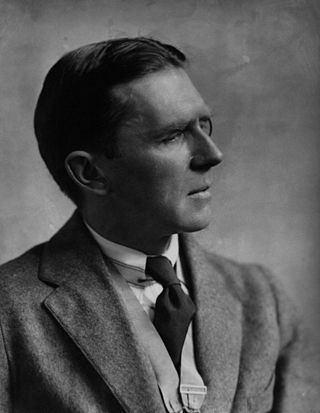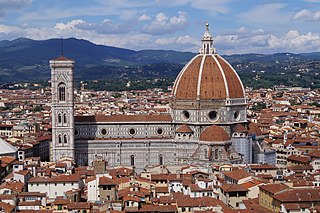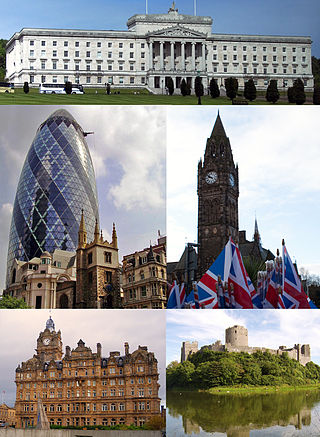
The Broads is a network of mostly navigable rivers and lakes in the English counties of Norfolk and Suffolk. Although the terms "Norfolk Broads" and "Suffolk Broads" are correctly used to identify specific areas within the two counties respectively, the whole area is frequently referred to as the Norfolk Broads.

Norwich is a cathedral city and district of the county of Norfolk, England, of which it is the county town. It lies by the River Wensum, about 100 mi (160 km) north-east of London, 40 mi (64 km) north of Ipswich and 65 mi (105 km) east of Peterborough. The population of the Norwich City Council local authority area was estimated to be 144,000 in 2021, which was an increase from 143,135 in 2019. The wider built-up area had a population of 213,166 in 2019.

Wood Quay is a riverside area of Dublin that was a site of Viking settlement. It is now the location of the Dublin City Council offices.

Sir Leslie Patrick Abercrombie was an English architect, urban designer and town planner, best known as the man who created London. Abercrombie was an academic during most of his career, and prepared one city plan and several regional studies prior to the Second World War. He came to prominence in the 1940s for his urban plans of the cities of Plymouth, Hull, Bath, Bournemouth, Hong Kong, Addis Ababa, Cyprus, Edinburgh, Clyde Valley and Greater London.
The architecture of Bosnia and Herzegovina is largely influenced by four major periods, when political and social changes determined the creation of distinct cultural and architectural habits of the region.

Birmingham Civic Society is a voluntary body in Birmingham, England, and is registered with the Civic Trust.
This article covers the architecture of Sweden from a historical perspective.

Friars Quay is a residential development of a high density, urban design of the 1970s. The development is located in the Colegate area at the centre of Norwich, Norfolk, bounded on one side by the River Wensum and by a park and two notable bridges to the east and west. Several historic churches surround the site creating an attractive and varied landscape. The population is included in the Mancroft ward of Norwich City.

Leeds Civic Trust is a voluntary organisation and registered charity established in Leeds, West Yorkshire, England in 1965. Affiliated to the national charity Civic Voice, its stated purpose is "to stimulate public interest in and care for the beauty, history, and character of the city and locality, to encourage high standards of design, architecture and town planning; [and] to encourage the development and improvement of features of general public amenity".

Architecture is the art and technique of designing and building, as distinguished from the skills associated with construction. It is both the process and the product of sketching, conceiving, planning, designing, and constructing buildings or other structures. The term comes from Latin architectura; from Ancient Greek ἀρχιτέκτων (arkhitéktōn) 'architect'; from ἀρχι- (arkhi-) 'chief' and τέκτων (téktōn) 'creator'. Architectural works, in the material form of buildings, are often perceived as cultural symbols and as works of art. Historical civilisations are often identified with their surviving architectural achievements.

The architecture of the United Kingdom, or British architecture, consists of a combination of architectural styles, dating as far back to Roman architecture, to the present day 21st century contemporary. England has seen the most influential developments, though Ireland, Scotland, and Wales have each fostered unique styles and played leading roles in the international history of architecture. Although there are prehistoric and classical structures in the United Kingdom, British architectural history effectively begins with the first Anglo-Saxon Christian churches, built soon after Augustine of Canterbury arrived in Great Britain in 597. Norman architecture was built on a vast scale throughout Great Britain and Ireland from the 11th century onwards in the form of castles and churches to help impose Norman authority upon their dominions. English Gothic architecture, which flourished between 1180 until around 1520, was initially imported from France, but quickly developed its own unique qualities.

Norwich 12 was an initiative by the Norwich Heritage Economic and Regeneration Trust (HERT) to develop 12 of Norwich's most iconic buildings into an integrated family of heritage attractions to act as an international showcase of English urban and cultural development over the last 1,000 years.
The London Society is a British membership organisation established to encourage public interest and participation in urban planning and transport matters in London as well as to study and celebrate the capital's unique history and character. It is among the oldest civic societies in the United Kingdom.

Edward Boardman (1833–1910) was a Norwich born architect. He succeeded John Brown as the most successful Norwich architect in the second half of the 19th century. His work included both civic and ecclesiastical buildings, in addition to private commissions. Together, with his rival, George Skipper, he produced many notable buildings with several standing to this day (2013).

Mile Cross Estate is a council estate in Norwich, England. The population of the Mile Cross Ward in Norwich at the 2011 census was 10,655.
Les Dennis Beilinson was an American architect and preservationist. He was known for his work in Miami's Art Deco district, both preserving existing architecture and ensuring its ongoing viability through modernization and upgrade for commercial purposes. As a founding member of the City of Miami Historic Preservation board, Beilinson was a defender of the glory days of 1940s and 1950s Miami against threats from unmoderated development. Beilinson was the founding partner of Beilinson Gomez Architects, PA, in partnership with Jose Gomez, AIA.

David Hodgson was a professional English painter of landscapes and an active member of the Norwich School of painters. He was the son of the amateur artist Charles Hodgson, whom he accompanied on a tour of Wales in 1805, when he was seven. He was taught art by John Crome at Norwich Grammar School.
The Georgian Society for East Yorkshire is the oldest group or society in the United Kingdom dedicated to the appreciation and preservation of Georgian architecture. The society is based in the East Riding of Yorkshire and is concerned with the preservation of buildings in the East Riding and Kingston-upon-Hull.

David Eyre Percival was a British Architect and Town Planner, known for his work as the City Architect of Norwich, where he pioneered what has been called a Vernacular Revival Style. His work can be seen across the city of Norwich and several of his developments were awarded.

Henry Castree Hughes, known as H. C. Hughes or Hugh Hughes, was a British architect and conservationist. He spent his entire career in Cambridge, where he practised architecture from 1923, latterly as Hughes and Bicknell with Peter Bicknell, and lectured in design at the School of Architecture of the University of Cambridge (1919–32). As an architect, he is best known for his Modernist buildings of the 1930s, particularly the Mond Building (1931–32) and Fen Court, Peterhouse (1939–40), although much of his output was traditional in style. He also carried out restoration work on cottages, Cambridge college buildings, and churches, including the Lady Chapel of Ely Cathedral. He was an elected fellow of the Royal Institute of British Architects.














